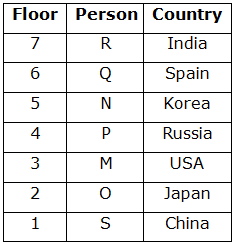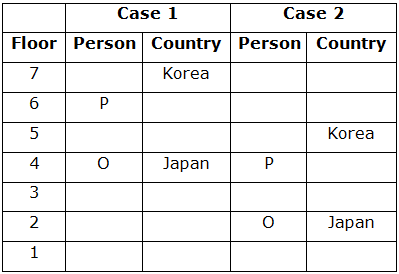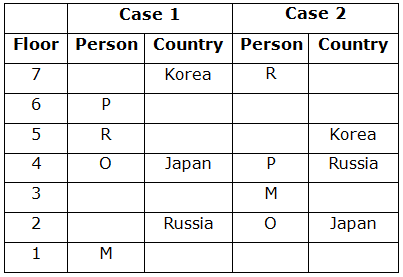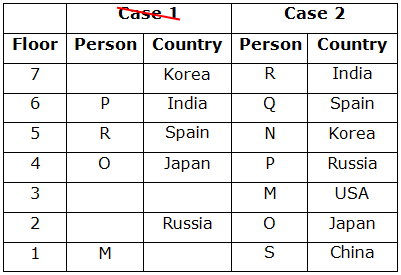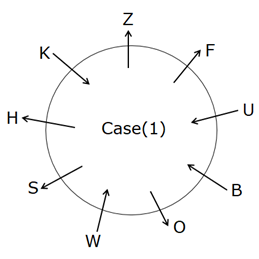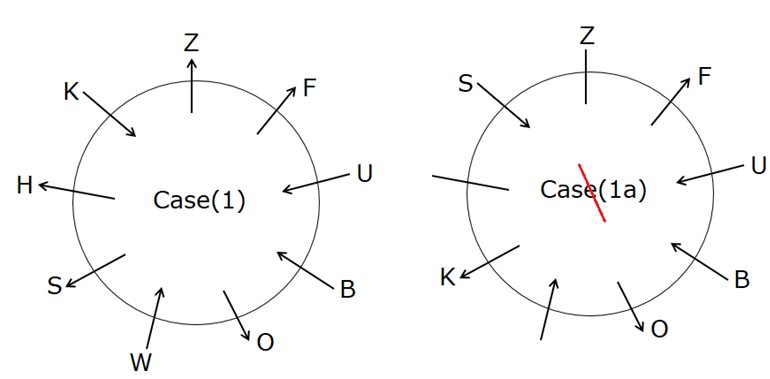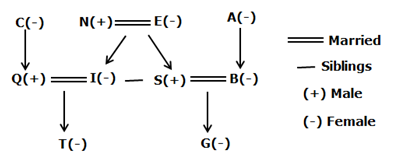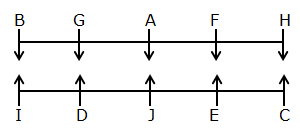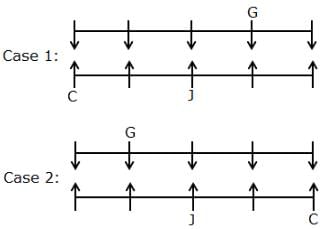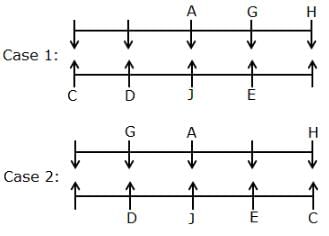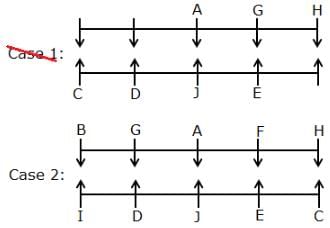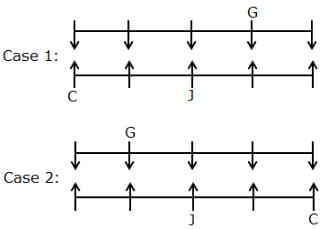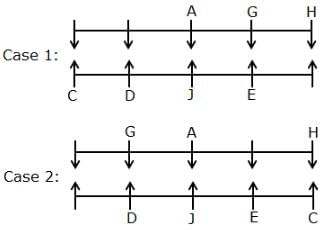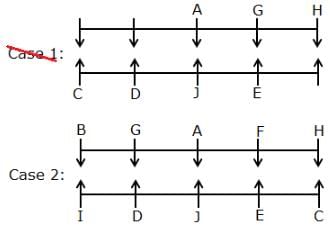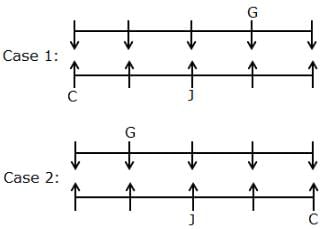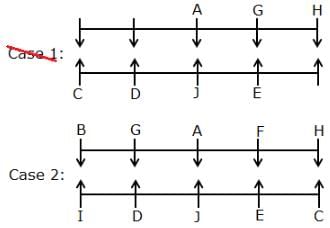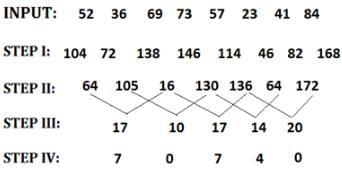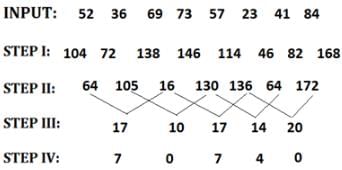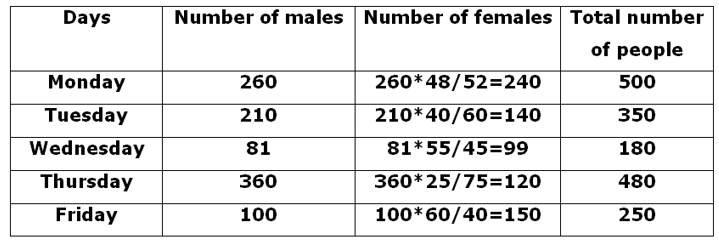IDBI Assistant Manager Mock Test - 2 - Bank Exams MCQ
30 Questions MCQ Test - IDBI Assistant Manager Mock Test - 2
Study the following information carefully and answer the questions given below.
Seven persons viz. M, N, O, P, Q, R and S are living in different floors of a seven storey building such that the lowermost floor is numbered as 1, the floor immediately above it is numbered as 2 and so on till the topmost floor is numbered as 7. Each person is from different countries viz. China, India, Japan, Korea, Russia, Spain and USA. All the information is not necessarily in the same order.
O lives in an even numbered floor and three floors below the one who is from Korea. P lives immediately below the one who is from Korea and two floors above the one who is from Japan. The number of floors above P is the same as the number of floors below the one who is from Russia. R lives three floors above the one who is from Russia, who lives immediately above M. The one who is from Spain lives immediately below the one who is from India and immediately above N. S is neither from Spain nor from USA.
Q. Who among the following person is from Spain?
Seven persons viz. M, N, O, P, Q, R and S are living in different floors of a seven storey building such that the lowermost floor is numbered as 1, the floor immediately above it is numbered as 2 and so on till the topmost floor is numbered as 7. Each person is from different countries viz. China, India, Japan, Korea, Russia, Spain and USA. All the information is not necessarily in the same order.
O lives in an even numbered floor and three floors below the one who is from Korea. P lives immediately below the one who is from Korea and two floors above the one who is from Japan. The number of floors above P is the same as the number of floors below the one who is from Russia. R lives three floors above the one who is from Russia, who lives immediately above M. The one who is from Spain lives immediately below the one who is from India and immediately above N. S is neither from Spain nor from USA.
Study the following information carefully and answer the questions given below.
Seven persons viz. M, N, O, P, Q, R and S are living in different floors of a seven storey building such that the lowermost floor is numbered as 1, the floor immediately above it is numbered as 2 and so on till the topmost floor is numbered as 7. Each person is from different countries viz. China, India, Japan, Korea, Russia, Spain and USA. All the information is not necessarily in the same order.
O lives in an even numbered floor and three floors below the one who is from Korea. P lives immediately below the one who is from Korea and two floors above the one who is from Japan. The number of floors above P is the same as the number of floors below the one who is from Russia. R lives three floors above the one who is from Russia, who lives immediately above M. The one who is from Spain lives immediately below the one who is from India and immediately above N. S is neither from Spain nor from USA.
Q. How many floors are there between N and the one who is from Japan?
Seven persons viz. M, N, O, P, Q, R and S are living in different floors of a seven storey building such that the lowermost floor is numbered as 1, the floor immediately above it is numbered as 2 and so on till the topmost floor is numbered as 7. Each person is from different countries viz. China, India, Japan, Korea, Russia, Spain and USA. All the information is not necessarily in the same order.
O lives in an even numbered floor and three floors below the one who is from Korea. P lives immediately below the one who is from Korea and two floors above the one who is from Japan. The number of floors above P is the same as the number of floors below the one who is from Russia. R lives three floors above the one who is from Russia, who lives immediately above M. The one who is from Spain lives immediately below the one who is from India and immediately above N. S is neither from Spain nor from USA.
Study the following information carefully and answer the questions given below.
Seven persons viz. M, N, O, P, Q, R and S are living in different floors of a seven storey building such that the lowermost floor is numbered as 1, the floor immediately above it is numbered as 2 and so on till the topmost floor is numbered as 7. Each person is from different countries viz. China, India, Japan, Korea, Russia, Spain and USA. All the information is not necessarily in the same order.
O lives in an even numbered floor and three floors below the one who is from Korea. P lives immediately below the one who is from Korea and two floors above the one who is from Japan. The number of floors above P is the same as the number of floors below the one who is from Russia. R lives three floors above the one who is from Russia, who lives immediately above M. The one who is from Spain lives immediately below the one who is from India and immediately above N. S is neither from Spain nor from USA.
Q. M is from which of the following country?
Seven persons viz. M, N, O, P, Q, R and S are living in different floors of a seven storey building such that the lowermost floor is numbered as 1, the floor immediately above it is numbered as 2 and so on till the topmost floor is numbered as 7. Each person is from different countries viz. China, India, Japan, Korea, Russia, Spain and USA. All the information is not necessarily in the same order.
O lives in an even numbered floor and three floors below the one who is from Korea. P lives immediately below the one who is from Korea and two floors above the one who is from Japan. The number of floors above P is the same as the number of floors below the one who is from Russia. R lives three floors above the one who is from Russia, who lives immediately above M. The one who is from Spain lives immediately below the one who is from India and immediately above N. S is neither from Spain nor from USA.
In each of the following questions, the relationship between different elements is shown in the statements followed by three conclusions. Find the conclusion which is definitely true.
Q. Statements:
H > B > P ≤ S; V = T ≤ P; C < D = W ≤ V
Conclusions:
I. B < W
II. H ≥ T
III. D ≤ S
Study the following information carefully and answer the below questions.
Nine persons – B, F, H, K, O, S, U, W, and Z are sitting around a circular table in such a way that some of them are facing the center whereas other sits facing away from the center.. Not more than two persons sitting together are facing in the same direction.
O sits third to the right of F, both are facing in the same direction. Neither O nor F sits adjacent to K. The person sitting immediate right of K sits fourth to the right of U. U doesn’t sit adjacent to O but sits facing center. K and S, who doesn’t sit adjacent to F, are sitting second to the right of each other. Z sits third to the right of B. Neither S nor F sits adjacent to B. The persons sitting adjacent to B are facing in opposite direction. H and W are sitting second to the left of each other. W and K are not sitting together. Z and O are facing the same direction.
Q. What is the position of Z with respect to W?
Study the following information carefully and answer the below questions.
Nine persons – B, F, H, K, O, S, U, W, and Z are sitting around a circular table in such a way that some of them are facing the center whereas other sits facing away from the center.. Not more than two persons sitting together are facing in the same direction.
O sits third to the right of F, both are facing in the same direction. Neither O nor F sits adjacent to K. The person sitting immediate right of K sits fourth to the right of U. U doesn’t sit adjacent to O but sits facing center. K and S, who doesn’t sit adjacent to F, are sitting second to the right of each other. Z sits third to the right of B. Neither S nor F sits adjacent to B. The persons sitting adjacent to B are facing in opposite direction. H and W are sitting second to the left of each other. W and K are not sitting together. Z and O are facing the same direction.
Q. How many persons are sitting between O and S, when counted to the left of S?
Study the following information carefully and answer the below questions.
Nine persons – B, F, H, K, O, S, U, W, and Z are sitting around a circular table in such a way that some of them are facing the center whereas other sits facing away from the center.. Not more than two persons sitting together are facing in the same direction.
O sits third to the right of F, both are facing in the same direction. Neither O nor F sits adjacent to K. The person sitting immediate right of K sits fourth to the right of U. U doesn’t sit adjacent to O but sits facing center. K and S, who doesn’t sit adjacent to F, are sitting second to the right of each other. Z sits third to the right of B. Neither S nor F sits adjacent to B. The persons sitting adjacent to B are facing in opposite direction. H and W are sitting second to the left of each other. W and K are not sitting together. Z and O are facing the same direction.
Q. Which of the following statement is/are true?
I. B sits fourth to the right of H.
II. Z sits second to the right of the one who sits third to the right of W.
III. Two persons are sitting between O and the one who sits third to the left of F when counted to the right of O.
Study the following information carefully and answer the below questions.
Q is the father of T who is the only daughter of I. S is the only son of E. B is the sister-in-law of I. C is the mother of Q. N is the father-in-law of B and father of S. A is the mother-in-law of S. G is the niece of I. Neither B nor Q has no siblings.
Q. How G is related to B?
Study the following information carefully and answer the questions given below.
Eleven persons viz. A, B, C, D, E, F, G, H, I, J and K are working in a company under different departments viz. Finance, Marketing, Production and Service, but not necessarily in the same order. Atleast two persons and atmost three persons are working in each department.
D is neither working in Marketing nor Production but works with G. Both C and K are working in the same department but not in Marketing. Both F and E are working in different departments but neither with G nor with K. Only A works alone with E but neither in Marketing nor Service. Both B and I are working in the same department whereas both J and H are working in different departments. H neither works in Finance nor Production whereas J doesn’t work in the same department as K.
Q. Who among the following person is working along with J?
Study the following information carefully and answer the questions given below.
Eleven persons viz. A, B, C, D, E, F, G, H, I, J and K are working in a company under different departments viz. Finance, Marketing, Production and Service, but not necessarily in the same order. Atleast two persons and atmost three persons are working in each department.
D is neither working in Marketing nor Production but works with G. Both C and K are working in the same department but not in Marketing. Both F and E are working in different departments but neither with G nor with K. Only A works alone with E but neither in Marketing nor Service. Both B and I are working in the same department whereas both J and H are working in different departments. H neither works in Finance nor Production whereas J doesn’t work in the same department as K.
Q. In which of the following department does K was working?
Study the following information carefully and answer the questions given below.
Eleven persons viz. A, B, C, D, E, F, G, H, I, J and K are working in a company under different departments viz. Finance, Marketing, Production and Service, but not necessarily in the same order. Atleast two persons and atmost three persons are working in each department.
D is neither working in Marketing nor Production but works with G. Both C and K are working in the same department but not in Marketing. Both F and E are working in different departments but neither with G nor with K. Only A works alone with E but neither in Marketing nor Service. Both B and I are working in the same department whereas both J and H are working in different departments. H neither works in Finance nor Production whereas J doesn’t work in the same department as K.
Q. Which of the following combination is true?
Study the information given carefully and answer the questions that follow
It is a fact that the global travel industry is one of the, if not the, hardest hit industries in the COVID-19 pandemic. At the peak of the lockdown measures across Europe, several countries experienced a staggering 99% decrease in bookings on popular accommodation sites such as Airbnb, Expedia and Booking.com compared to 2019. As countries shut their borders to protect their citizens, global tourism came to a complete halt. This hugely impacted the entire tourism ecosystem, resulting in a significant drop of movement and occupancy in the airline and hospitality industries.
Q. Find the best line that concludes the given paragraph in the most appropriate manner
Read the following carefully and answer the questions that follow
Statement: The recently announced vehicle scrappage scheme is likely to usher in significant change in the Indian automobile industry and is expected to generate demand for new vehicles, especially commercial vehicles.
Conclusions:
(I) The scrappage policy could change India’s automobile sector
(II) Scrapyards are likely to be established in the four zones
Study the following information carefully and answer the questions given below.
Ten persons viz. A, B, C, D, E, F, G, H, I and J are sitting in two parallel rows such that the persons in row 1 face north whereas the persons in row 2 face south, but not necessarily in the same order. The persons in both rows face towards each other.
C faces north and sits on one of the ends of the row. Two persons sit between C and the one who faces G. J sits on the middle of the row but not adjacent to G. H faces the one who sits second to the right of J. The number of persons sit between G and H is the same as between C and D. E sits to the immediate right of the one who faces A, who doesn’t sit adjacent to J. B sits on the same row as F, who neither sits on the ends nor to the right of A.
Q. Who among the following person sits to the immediate left of D?
Study the following information carefully and answer the questions given below.
Ten persons viz. A, B, C, D, E, F, G, H, I and J are sitting in two parallel rows such that the persons in row 1 face north whereas the persons in row 2 face south, but not necessarily in the same order. The persons in both rows face towards each other.
C faces north and sits on one of the ends of the row. Two persons sit between C and the one who faces G. J sits on the middle of the row but not adjacent to G. H faces the one who sits second to the right of J. The number of persons sit between G and H is the same as between C and D. E sits to the immediate right of the one who faces A, who doesn’t sit adjacent to J. B sits on the same row as F, who neither sits on the ends nor to the right of A.
Q. What is the position of G with respect to B?
Study the following information carefully and answer the questions given below.
Ten persons viz. A, B, C, D, E, F, G, H, I and J are sitting in two parallel rows such that the persons in row 1 face north whereas the persons in row 2 face south, but not necessarily in the same order. The persons in both rows face towards each other.
C faces north and sits on one of the ends of the row. Two persons sit between C and the one who faces G. J sits on the middle of the row but not adjacent to G. H faces the one who sits second to the right of J. The number of persons sit between G and H is the same as between C and D. E sits to the immediate right of the one who faces A, who doesn’t sit adjacent to J. B sits on the same row as F, who neither sits on the ends nor to the right of A.
Q. How many persons sit between A and F?
When a number arrangement machine is given an input line of numbers, it arranges them following a particular rule. The following is an illustration of an input and its rearrangement.
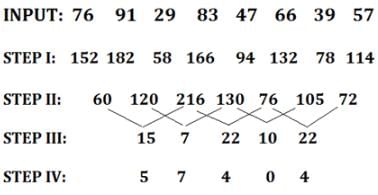
Step IV, is the last step of the above arrangement as the intended arrangement is obtained.
As per the rules followed in the given steps find out the appropriate steps for the given input:
Input: 52 36 69 73 57 23 41 84
Q. Which element is 2nd to the right of the one which is 4th from the left end in step II?
When a number arrangement machine is given an input line of numbers, it arranges them following a particular rule. The following is an illustration of an input and its rearrangement.
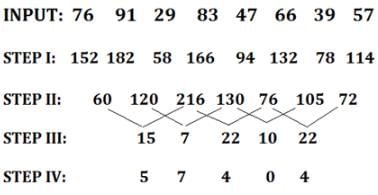
Step IV, is the last step of the above arrangement as the intended arrangement is obtained.
As per the rules followed in the given steps find out the appropriate steps for the given input:
Input: 52 36 69 73 57 23 41 84
Q. Which element is 5th from the left end in Step III?
Read the following information carefully and answer the questions.
The given line graph shows the number of males who watched movies in a theater on five different days i.e. Monday, Tuesday, Wednesday, Thursday and Friday and also given the percentage of number of females who watched movies on five different days.
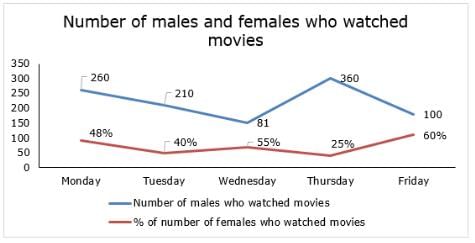
Note: Total number of people who watched movies=Number of males who watched movies+ Number of females who watched movies.
Q. If the total number of people who watched movies on Sunday is 40% more than that on Friday and number of males who watched movies on Sunday is 110 more than that on Friday, then find the number of females who watched movies on Sunday?
Read the following information carefully and answer the questions.
The given line graph shows the number of males who watched movies in a theater on five different days i.e. Monday, Tuesday, Wednesday, Thursday and Friday and also given the percentage of number of females who watched movies on five different days.
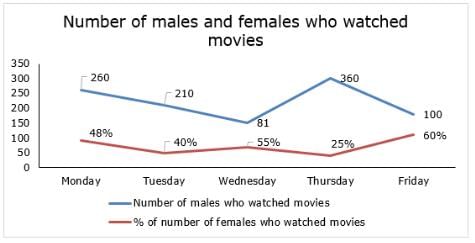
Note: Total number of people who watched movies=Number of males who watched movies+ Number of females who watched movies.
Q. Out of total number of people who watched movies on Wednesday, 25% are watched in English and the remaining people who watched in Hindi. If the ratio of number of males who watched movies in Hindi and English on Wednesday is 5:4, then find number of females who watched movies in Hindi on Wednesday?
Study the following information carefully and answer the questions given below.
The given bar graph shows the total number of employees and the number of male employees in five different companies.
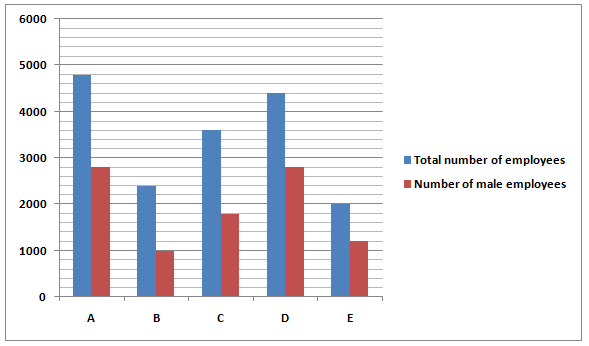
Q. If the number of female employees in F is 40% more than that of D and the total number of employees in F is 3200, then find the number of male employees in F?
Study the following information carefully and answer the questions given below.
The given bar graph shows the total number of employees and the number of male employees in five different companies.

Q. Find the average number of female employees in all the companies together?
Study the following information carefully and answer the questions given below.
The given bar graph shows the total number of employees and the number of male employees in five different companies.

Q. The number of male employees in C and E together is what percent of the total number of employees in A and D together?
Read the following information carefully and answer the questions.
The given table chart shows the average number of mango and blueberry plants cultivated in five different months i.e. January, February, March, April and May and also given the percentage of number of mango plants cultivated out of the total number of mango and blueberry plants cultivated in five different months and the difference between number of blueberry and papaya plants cultivated in five different months.
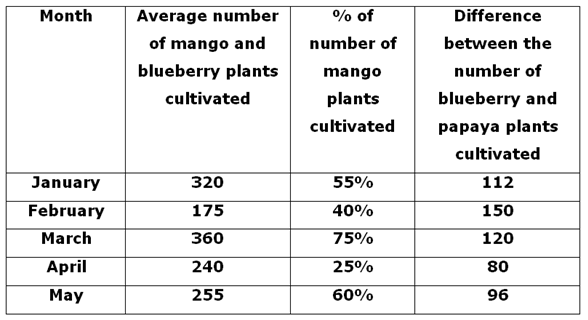
Note: In every month, the number of blueberry plants cultivated is less than the number of papaya plants cultivated.
Q. If the number of blueberry and papaya plants cultivated in June is 40% less than that of April and the number of mango plants cultivated in June is two times the number of mango plants cultivated in April, then find the total number of plants cultivated in June.
Read the following information carefully and answer the questions.
The given table chart shows the average number of mango and blueberry plants cultivated in five different months i.e. January, February, March, April and May and also given the percentage of number of mango plants cultivated out of the total number of mango and blueberry plants cultivated in five different months and the difference between number of blueberry and papaya plants cultivated in five different months.

Note: In every month, the number of blueberry plants cultivated is less than the number of papaya plants cultivated.
Q. Number of blueberry plants cultivated in March and April together is what percentage more than the number of papaya plants cultivated in January?
Study the bar graph and table given below carefully and answer the following questions.
The below line graph shows the total number of persons who are visiting Chennai in 5 different months of a year and the table chart shows the percentage of foreign visitors in 5 different months.
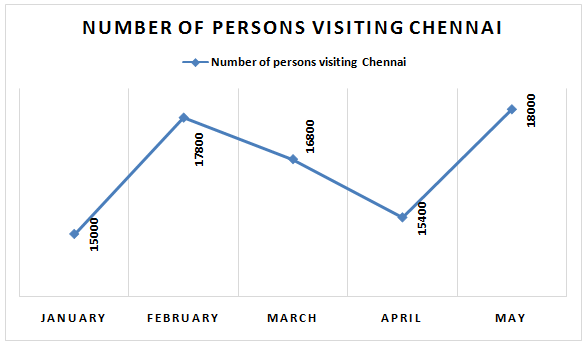
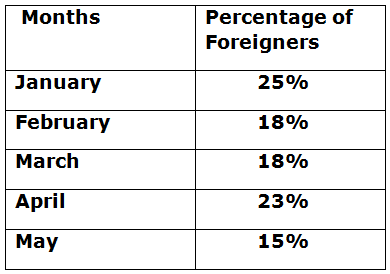
Note: Total persons = Indians + Foreigners
Q. If the total number of Indian visitors in June is 35/17 % of the total number of Indians visitors in May and the total visitors in June are 4/3rd of the total visitors in January. Then find the difference between the total number of foreign and Indian visitors who visited in June.
Study the bar graph and table given below carefully and answer the following questions.
The below line graph shows the total number of persons who are visiting Chennai in 5 different months of a year and the table chart shows the percentage of foreign visitors in 5 different months.


Note: Total persons = Indians + Foreigners
Q. If the ratio of the Indian male to female visitors in January is 2 : 3 and the ratio of foreign male to female visitors in March is 1 : 5, then find the ratio of Indian female visitors in January to foreign male visitors in March.
Study the bar graph and table given below carefully and answer the following questions.
The below line graph shows the total number of persons who are visiting Chennai in 5 different months of a year and the table chart shows the percentage of foreign visitors in 5 different months.


Note: Total persons = Indians + Foreigners
Q. Foreign visitors in May are what percent of the Indian visitors in January?
Study the following information carefully and answer the questions given below.
The given pie chart shows the total number of TV sold (online and offline) in five different months.
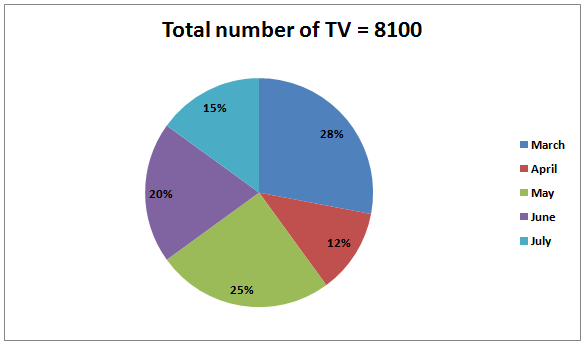
The given table shows the ratio of the number of TVs sold online and offline in five different months.

Q. What is the average number of TV sold offline in April and July together?
Study the following information carefully and answer the questions given below.
The given pie chart shows the total number of TV sold (online and offline) in five different months.

The given table shows the ratio of the number of TVs sold online and offline in five different months.

Q. What is the ratio of the number of TVs sold offline in March and July together to the number of TVs sold online in June and July together?


